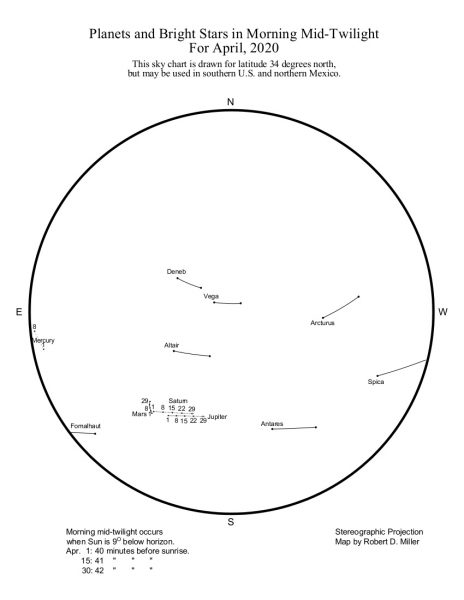April Astronomy: In These Isolated, Scary Times, Take Solace by Going Outside and Looking at the Wonders of the Universe – Coachella Valley Independent
In the western sky at dusk, Venus in April attains its greatest brilliance of this year. Before dawn, the three bright outer planets—Mars, Jupiter and Saturn—are visible in the southeast before dawn.
In the evening: Going eastward against the background stars of Taurus at a decreasing pace, Venus loses altitude late in the month. This occurs as Venus comes around to the near side of its orbit, slowing its progress among the zodiac constellations to less than the sun’s rate of one degree per day. Venus attains peak brilliance in its crescent phase in late April.
Winter’s bright stars have moved into the western sky, most of them poised to depart in May. These include Orion’s red supergiant star Betelgeuse, now recovering from its record fade of January and February. Regulus, heart of Leo, climbs high in the south, and golden Arcturus ascends in the east to east-northeast. To Arcturus’ lower right at dusk, blue-white Spica stands at opposition to the sun on April 13 and is visible almost all night.
Binoculars give stunning nightly views! On April 1, two days before the very close pairing of Venus with third-magnitude Alcyone, or Eta Tauri, the brightest star of the Pleiades, they’re within 1.8 degrees. They’ll be less than 0.3 degrees apart on April 3. Binoculars will certainly come in handy for observing the close conjunction!
Venus will be moving east against background stars by about 0.9 degrees per day, pulling away from the Pleiades. On April 5, Venus and Alcyone are 1.9 degrees apart.
Mornings: The gap between Jupiter and Saturn is 6 degrees on April 6, closing to 5 degrees by April 28. Mars moves rapidly east against background stars, increasing its distance east of Saturn from 1 degree on April 1, to 20 degrees on May 1. Stars on April mornings are in locations similar to where we’ll find them in late August and early September at dusk: The Summer Triangle of Vega, Altair and Deneb is approaching overhead, with Arcturus in the west, Antares in the southwest, and Spica setting in the west-southwest. From April 14-16, the moon visits the three bright outer planets, while the moon goes from 6 degrees west of Jupiter to nearly 5 degrees east of Mars.
Venus-moon conjunction in the evening: At sunset on April 26, find Venus about 7 degrees to the right of the 15-percent crescent moon and a little lower. Venus is itself a crescent, 28 percent full and 37 arcseconds across—large enough to detect its shape with a steadily held pair of binoculars. The most fascinating views of Venus, both in daytime and at dusk, are yet to come, in May.
The star parties and lectures hosted by the Astronomical Society of the Desert have been canceled through at least the end of May, as an action to help prevent the spread of COVID-19. For updates on the resumption of activities, check the club’s website at www.astrorx.org. The Rancho Mirage Library’s Observatory is currently closed as well; watch www.ranchomiragelibrary.org/observatory.html for updates.
In the meantime, schedule your own sky-watching routines! Every spring, in nightly outings during the first hour after sunset—perhaps while walking your dog—you can enjoy following the seasonal departure of bright stars into the western twilight glow. In order of date, they are Rigel, Aldebaran, the Dog Star Sirius, Betelgeuse and, in 2020 before the end of May, Venus. A close conjunction of departing Venus with emerging Mercury will take place on May 21. By the start of June, of winter’s luminaries, only an arch of four bright stars remains: from left to right, Procyon, the “Twins” Pollux and Castor, and Capella.
Using binoculars or a telescope during bright twilight, follow the changing crescent phases of Venus, just after sunset in April and May, and just before sunrise in June and July.
You can also follow the moon nightly at dusk, as it waxes from a thin crescent in the west to full in the east. Then, you can switch to predawn viewing to follow the moon waning from full in the west to a thin crescent in the east.
Early risers in spring 2020 can follow the three bright outer planets in the southeast to southern sky: Bright Jupiter pauses within 5 degrees west of Saturn from late April through early June, while red, brightening Mars pulls away to their east.
Beautiful gatherings of the moon, planets and stars are illustrated In the Abrams Planetarium Sky Calendar. For subscription information and a sample copy, visit www.abramsplanetarium.org/SkyCalendar. The sample is the April 2020 issue, with its evening sky map. Please enjoy and share it with others.
Stay safe! Here’s wishing you clear skies!
Robert C. Victor was a staff astronomer at Abrams Planetarium at Michigan State University. Now retired, he often collaborates with John S. French on the Sky Calendar, and enjoys providing sky-watching opportunities for a variety of groups, mostly in the California desert and in Michigan.







